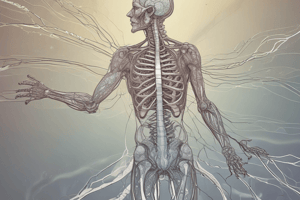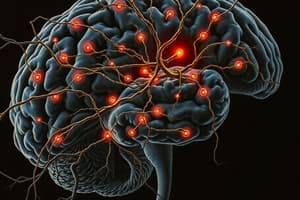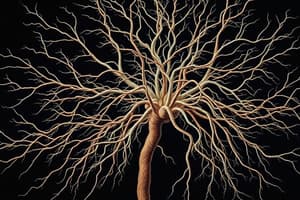Podcast
Questions and Answers
Which part of the brain controls homeostasis of the body?
Which part of the brain controls homeostasis of the body?
- Pons
- Cerebrum
- Hypothalamus (correct)
- Medulla oblongata
The somatic system is responsible for the 'fight or flight' response.
The somatic system is responsible for the 'fight or flight' response.
False (B)
What is the primary function of the cerebellum?
What is the primary function of the cerebellum?
Balance, posture, and coordination.
The ______ nervous system is responsible for processing reflexes.
The ______ nervous system is responsible for processing reflexes.
Match the parts of the autonomic nervous system with their functions:
Match the parts of the autonomic nervous system with their functions:
Which of the following is NOT a part of the central nervous system?
Which of the following is NOT a part of the central nervous system?
The cerebellum is responsible for processing sensory information.
The cerebellum is responsible for processing sensory information.
What are the main parts of the brainstem?
What are the main parts of the brainstem?
The central nervous system consists of the brain and the __________.
The central nervous system consists of the brain and the __________.
Which part of the nervous system includes sensory and motor neurons?
Which part of the nervous system includes sensory and motor neurons?
Match the following parts of the brain with their functions:
Match the following parts of the brain with their functions:
The peripheral nervous system consists only of motor neurons.
The peripheral nervous system consists only of motor neurons.
What is the primary function of the thalamus?
What is the primary function of the thalamus?
The cerebellum is located at the front of the brain.
The cerebellum is located at the front of the brain.
What part of the brain helps control the rate of breathing?
What part of the brain helps control the rate of breathing?
The __________ regulates body temperature and appetite.
The __________ regulates body temperature and appetite.
Which part of the nervous system extends from the brain to the lower back?
Which part of the nervous system extends from the brain to the lower back?
The central nervous system includes the spinal cord and peripheral nerves.
The central nervous system includes the spinal cord and peripheral nerves.
What is the main role of the medulla oblongata?
What is the main role of the medulla oblongata?
Which part of the nervous system is responsible for controlling involuntary actions like heart rate and digestion?
Which part of the nervous system is responsible for controlling involuntary actions like heart rate and digestion?
The sympathetic division of the autonomic nervous system is responsible for the 'rest and digest' response.
The sympathetic division of the autonomic nervous system is responsible for the 'rest and digest' response.
What are the two main divisions of the autonomic nervous system?
What are the two main divisions of the autonomic nervous system?
The ______ is responsible for coordinating movement, balance, and posture.
The ______ is responsible for coordinating movement, balance, and posture.
Match the brain structures with their primary functions:
Match the brain structures with their primary functions:
Which system is responsible for voluntary movements and reflexes?
Which system is responsible for voluntary movements and reflexes?
The autonomic nervous system operates voluntarily and controls the heart rate.
The autonomic nervous system operates voluntarily and controls the heart rate.
What are the two branches of the autonomic nervous system?
What are the two branches of the autonomic nervous system?
The ______ nervous system carries impulses to the heart and internal organs.
The ______ nervous system carries impulses to the heart and internal organs.
Match the following branches of the autonomic nervous system with their functions:
Match the following branches of the autonomic nervous system with their functions:
What is the role of the somatic nervous system?
What is the role of the somatic nervous system?
The sympathetic nervous system is active during times of relaxation.
The sympathetic nervous system is active during times of relaxation.
Which system relays information from sensory receptors to the central nervous system?
Which system relays information from sensory receptors to the central nervous system?
The cerebellum is responsible for balance and coordination.
The cerebellum is responsible for balance and coordination.
Which part of the brain relays signals between the cerebrum and the cerebellum?
Which part of the brain relays signals between the cerebrum and the cerebellum?
The ______ regulates body appetite, thirst, and temperature.
The ______ regulates body appetite, thirst, and temperature.
What is the function of the medulla oblongata?
What is the function of the medulla oblongata?
The spinal cord is protected by the vertebrae.
The spinal cord is protected by the vertebrae.
What part of the Central Nervous System extends from the brain to the lower back?
What part of the Central Nervous System extends from the brain to the lower back?
What structures are included in the Central Nervous System (CNS)?
What structures are included in the Central Nervous System (CNS)?
The Peripheral Nervous System (PNS) includes neurons that are part of the central nervous system.
The Peripheral Nervous System (PNS) includes neurons that are part of the central nervous system.
Name one function of sensory neurons in the Peripheral Nervous System.
Name one function of sensory neurons in the Peripheral Nervous System.
The _________ is responsible for processing sensory information in the brain.
The _________ is responsible for processing sensory information in the brain.
Which part of the brainstem is NOT included in its basic components?
Which part of the brainstem is NOT included in its basic components?
The central nervous system contains both the brain and peripheral nerves.
The central nervous system contains both the brain and peripheral nerves.
List the parts included in the brainstem.
List the parts included in the brainstem.
Which part of the central nervous system is primarily responsible for controlling balance and coordination?
Which part of the central nervous system is primarily responsible for controlling balance and coordination?
The peripheral nervous system is primarily made up of interneurons.
The peripheral nervous system is primarily made up of interneurons.
What two main divisions make up the nervous system?
What two main divisions make up the nervous system?
The _____ nervous system is considered the control center of the body.
The _____ nervous system is considered the control center of the body.
Match the parts of the brain to their primary functions:
Match the parts of the brain to their primary functions:
What is the primary function of the medulla oblongata?
What is the primary function of the medulla oblongata?
The brainstem is responsible for regulating voluntary activities.
The brainstem is responsible for regulating voluntary activities.
Impulses travel through the _____ to reach the brain.
Impulses travel through the _____ to reach the brain.
Flashcards
Central Nervous System (CNS)
Central Nervous System (CNS)
The control center of the body, composed of the brain and spinal cord.
Cerebrum
Cerebrum
The part of the CNS responsible for higher-level functions, like memory and muscle control.
Cerebellum
Cerebellum
Part of the CNS that coordinates movements, balance, and posture.
Brainstem
Brainstem
Signup and view all the flashcards
Peripheral Nervous System (PNS)
Peripheral Nervous System (PNS)
Signup and view all the flashcards
Interneurons
Interneurons
Signup and view all the flashcards
Sensory Neurons
Sensory Neurons
Signup and view all the flashcards
Motor Neurons
Motor Neurons
Signup and view all the flashcards
Medulla Oblongata
Medulla Oblongata
Signup and view all the flashcards
Pons
Pons
Signup and view all the flashcards
Hypothalamus
Hypothalamus
Signup and view all the flashcards
Spinal Cord
Spinal Cord
Signup and view all the flashcards
Peripheral Nervous System
Peripheral Nervous System
Signup and view all the flashcards
Nervous System
Nervous System
Signup and view all the flashcards
What is the brain?
What is the brain?
Signup and view all the flashcards
What's the spinal cord?
What's the spinal cord?
Signup and view all the flashcards
What are sensory neurons?
What are sensory neurons?
Signup and view all the flashcards
What are motor neurons?
What are motor neurons?
Signup and view all the flashcards
Somatic Nervous System
Somatic Nervous System
Signup and view all the flashcards
Somatic Motor Nerves
Somatic Motor Nerves
Signup and view all the flashcards
Autonomic Nervous System
Autonomic Nervous System
Signup and view all the flashcards
Sympathetic Nervous System
Sympathetic Nervous System
Signup and view all the flashcards
Parasympathetic Nervous System
Parasympathetic Nervous System
Signup and view all the flashcards
Reflexes
Reflexes
Signup and view all the flashcards
Somatic Nerves
Somatic Nerves
Signup and view all the flashcards
What makes up the Central Nervous System (CNS)?
What makes up the Central Nervous System (CNS)?
Signup and view all the flashcards
What is the Peripheral Nervous System (PNS)?
What is the Peripheral Nervous System (PNS)?
Signup and view all the flashcards
What is the Cerebrum?
What is the Cerebrum?
Signup and view all the flashcards
What is the Cerebellum?
What is the Cerebellum?
Signup and view all the flashcards
What does the Brainstem control?
What does the Brainstem control?
Signup and view all the flashcards
What are Interneurons?
What are Interneurons?
Signup and view all the flashcards
What is the Sympathetic Nervous System?
What is the Sympathetic Nervous System?
Signup and view all the flashcards
What does the Cerebrum do?
What does the Cerebrum do?
Signup and view all the flashcards
What is the Parasympathetic Nervous System?
What is the Parasympathetic Nervous System?
Signup and view all the flashcards
What is the Medulla Oblongata?
What is the Medulla Oblongata?
Signup and view all the flashcards
What is the Central Nervous System (CNS)?
What is the Central Nervous System (CNS)?
Signup and view all the flashcards
What is the role of the Cerebellum?
What is the role of the Cerebellum?
Signup and view all the flashcards
What does the Brainstem do?
What does the Brainstem do?
Signup and view all the flashcards
What do Sensory Neurons do?
What do Sensory Neurons do?
Signup and view all the flashcards
What do Motor Neurons do?
What do Motor Neurons do?
Signup and view all the flashcards
What do Interneurons do?
What do Interneurons do?
Signup and view all the flashcards
What is the Somatic Nervous System?
What is the Somatic Nervous System?
Signup and view all the flashcards
What is the Autonomic Nervous System?
What is the Autonomic Nervous System?
Signup and view all the flashcards
What are Somatic Motor Nerves?
What are Somatic Motor Nerves?
Signup and view all the flashcards
What are Reflexes?
What are Reflexes?
Signup and view all the flashcards
What is the Peripheral Nervous System?
What is the Peripheral Nervous System?
Signup and view all the flashcards
What is the Autonomic Nervous System's role?
What is the Autonomic Nervous System's role?
Signup and view all the flashcards
Study Notes
Lesson Goals and Vocabulary
- Students will be able to explain the nervous system and its parts.
- New vocabulary: Peripheral nervous system, Cerebrum, Cerebellum, Medulla oblongata
Lesson Agenda
- Welcome task
- Instruction and knowledge sharing
- Differentiated activities and teaching strategies
- Assessment
- Plenary
Success Criteria
- Explain the structure and parts of the CNS
High Order Thinking Skills (HOTS) Questions
- Have you ever felt a gagging sensation when a doctor put a tongue depressor in your mouth?
Warming Up Questions
- What are the major differences in the divisions of the nervous system?
- (Relevant video link provided)
The Central Nervous System (CNS)
- The nervous system consists of two major divisions:
- Central nervous system (CNS)
- Peripheral nervous system (PNS)
- Made up of brain and spinal cord
- Acts as the body's control center, coordinating activities
- Impulses travel through neurons in the body to reach the brain
- The CNS is mostly made up of interneurons.
- Coordinates all bodily activities
- Relays, processes information, and analyzes responses
The Brain
- The brain is sometimes called the control center of the entire body.
- The cerebrum is the largest part of the brain and carries out thought processes involved with learning, memory, speech, voluntary body movements, and sensory perception.
- The cerebellum controls balance, posture, and coordination, located at the back of the brain.
- The medulla oblongata relays signals between the brain and other parts of the body.
- The pons relays signals between the cerebrum and cerebellum, and helps control breathing.
- The hypothalamus regulates body temperature, thirst, balance, and partially regulates blood pressure, sleep, aggression, fear, and sexual behavior.
The Spinal Cord
- Nerve column that extends from the brain to the lower back
- Protected by the vertebrae
- Processes information
The Peripheral Nervous System (PNS)
- Consists of sensory and motor neurons that carry information to and from the CNS
- Neurons in the peripheral nervous system are classified as either part of the somatic nervous system or the autonomic nervous system.
The Somatic Nervous System
- Nerves in this system relay information from external sensory receptors to the CNS, controlling voluntary movements.
The Autonomic Nervous System
- Carries impulses from the CNS to the heart and other internal organs
- The body responds involuntarily, not under conscious control.
- The sympathetic nervous system is most active in times of emergency or stress, when the heart rate and breathing rate increase.
- The parasympathetic nervous system is most active when the body is relaxed.
Nervous System Assessment Questions
-
- The central nervous system consists of... (a) Brain, (b) Sensory fibers, (c) Spinal cord, (d) Cranial fibers
-
- The brainstem is composed of ... (a) Midbrain, (b) Thalamus, (c) Pons, (d) Medulla oblongata
-
- This part of the brain processes sensory information... (a) Cerebellum, (b) Cerebrum, (c) Medulla, (d) Nerves
Additional Information
- Provided lesson activities for different groups (e.g., describing the function of the nervous system, explaining folds and grooves in the cerebrum, discussing the importance of the CNS, position of the cerebrum in relation to the cerebellum, hypothesizing tests to assess brain function).
- Included a question about classifying the type of nervous system test and hypothesis needed by researchers.
- Provided quiz questions related to the nervous system, including the function of the hypothalamus, the term that best describes nerves relaying information from external receptors to the CNS, and the characteristics of the sympathetic nervous system.
Studying That Suits You
Use AI to generate personalized quizzes and flashcards to suit your learning preferences.



